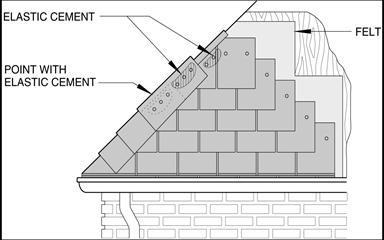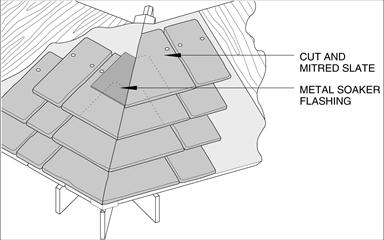Difference between revisions of "TS Details:E4.7.9 (Slate - Hips)"
Difference between revisions of "TS Details:E4.7.9 (Slate - Hips)"
(Created page with "<hr> Hips on a slate roof can be either mitred, saddled or have a metal flashing. Saddled hips require a lathe nailer on both sides thick enough to support the hip tiles from...") |
|||
| Line 1: | Line 1: | ||
| − | < | + | <div class="panel panel-success"> |
| + | <div class="panel-heading"><big>'''Slate Roofing Details'''</big></div> | ||
| + | <div class="panel-body"> | ||
| + | <div class="col-md-6"> | ||
| + | <div style="text-align:center; vertical-align:center"> | ||
| + | [[File:7.4.1.2.6.jpg|class=img-responsive]] | ||
| + | |||
| + | [[File:7.4.1.2.7.jpg|class=img-responsive]] | ||
| + | </div> | ||
| + | </div><!-- COL-MD-6 --> | ||
| + | |||
| + | <div class="col-md-6"> | ||
| + | |||
Hips on a slate roof can be either mitred, saddled or have a metal flashing. | Hips on a slate roof can be either mitred, saddled or have a metal flashing. | ||
Saddled hips require a lathe nailer on both sides thick enough to support the hip tiles from the field tiles. The width should allow nailing and keep a 75 mm (3") lap over field tiles. Nail heads should be covered with elastic cement between successive tiles. | Saddled hips require a lathe nailer on both sides thick enough to support the hip tiles from the field tiles. The width should allow nailing and keep a 75 mm (3") lap over field tiles. Nail heads should be covered with elastic cement between successive tiles. | ||
| − | |||
| − | |||
On mitred hips, field slates are cut flush at the apex to match slates on the other side. The unexposed portion of these slates is covered with a metal flashing which should extend 50 mm up from the tiles being covered. | On mitred hips, field slates are cut flush at the apex to match slates on the other side. The unexposed portion of these slates is covered with a metal flashing which should extend 50 mm up from the tiles being covered. | ||
| − | + | </div><!-- COL-6-MD --> | |
| − | + | </div><!-- PANEL BODY --> | |
| + | </div><!-- PANEL --> | ||
<hr> | <hr> | ||
| Line 14: | Line 25: | ||
| − | [[Section:E. Application: Steep Slope Roofs|<i class="fa fa-chevron-circle-left fa | + | [[Section:E. Application: Steep Slope Roofs|<i class="fa fa-chevron-circle-left fa" ></i> Back to ''Slate Application'']] |
| − | [[Tile and Slate Construction Details|<i class="fa fa-chevron-circle-left fa | + | [[Tile and Slate Construction Details|<i class="fa fa-chevron-circle-left fa" ></i> Back to ''Tile and Slate Construction Details'']] |
| − | [[Section:G. Construction Details|<i class="fa fa-chevron-circle-left fa | + | [[Section:G. Construction Details|<i class="fa fa-chevron-circle-left fa" ></i> Back to ''Construction Details'']] |
Revision as of 21:20, 19 August 2016
Slate Roofing Details
Hips on a slate roof can be either mitred, saddled or have a metal flashing.
Saddled hips require a lathe nailer on both sides thick enough to support the hip tiles from the field tiles. The width should allow nailing and keep a 75 mm (3") lap over field tiles. Nail heads should be covered with elastic cement between successive tiles.
On mitred hips, field slates are cut flush at the apex to match slates on the other side. The unexposed portion of these slates is covered with a metal flashing which should extend 50 mm up from the tiles being covered.


